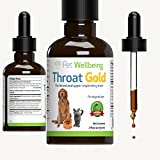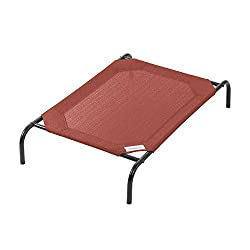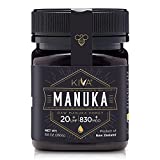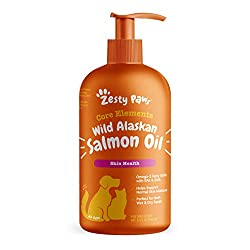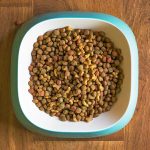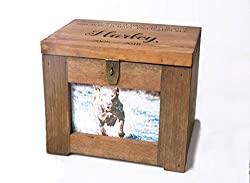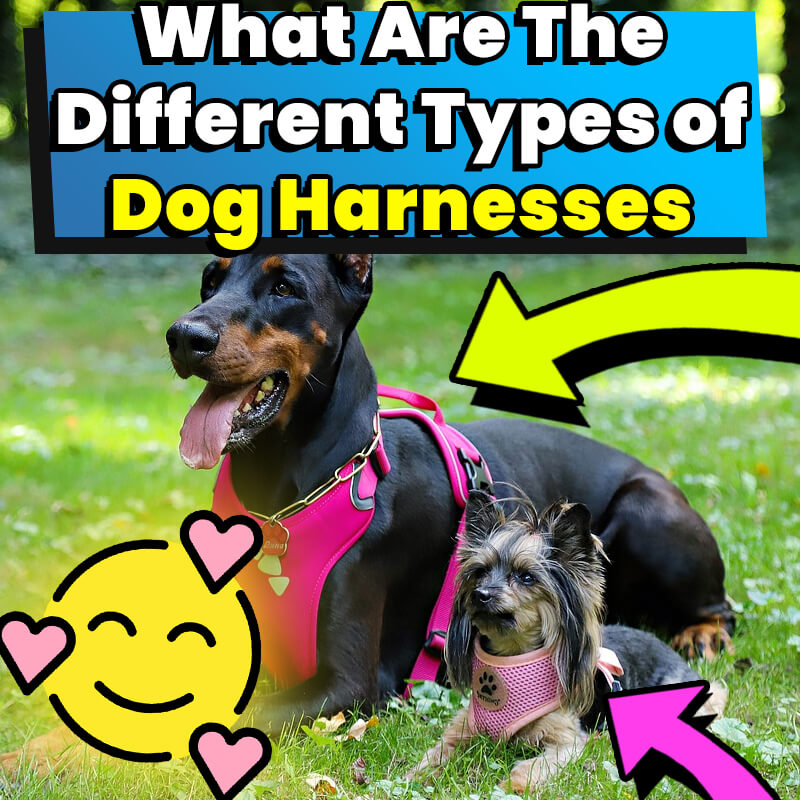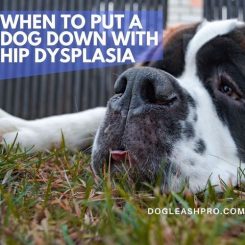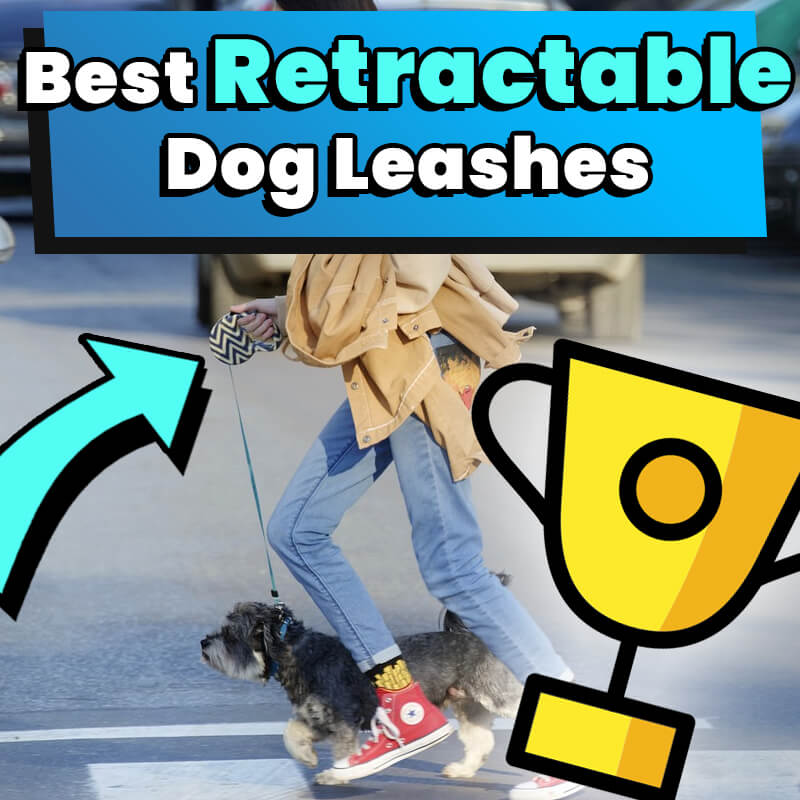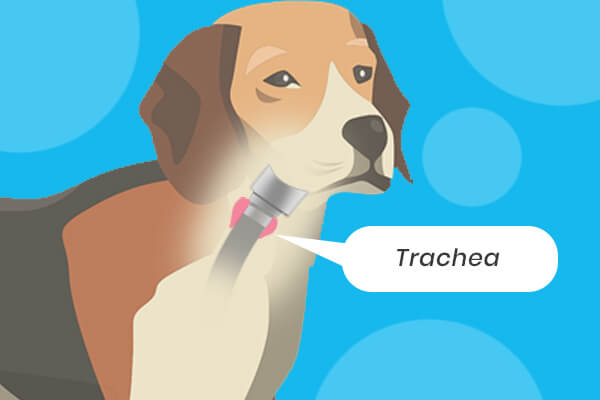
When to Euthanize a Dog with Tracheal Collapse? If you suspect your dog has Tracheal Collapse, the first step is to speak with your veterinarian. Based on the level of impact Tracheal Collapse has on your dog’s quality of life and their professional judgment, they can help you make the decision on when it is time to Euthanize your precious canine friend.
Navigating the decision of Euthanasia for a dog suffering from Tracheal Collapse is one of the most challenging experiences for a pet owner. This progressive disease is characterized by difficulty breathing and decreased quality of life. Treatments can manage it to an extent, but there inevitably comes a point where the question of Euthanasia arises.
This comprehensive guide aims to offer compassionate guidance during this difficult time. We’ll explore the nature of Tracheal Collapse, discussing the symptoms and the various treatment options available. We’ll provide insights into when these interventions can help extend your dog’s life while preserving a decent quality of life.
More importantly, we’ll guide you in recognizing the signs indicating when the disease has progressed to a point where Euthanasia might be the most humane choice. This is a complex and deeply personal decision based on a commitment to minimize your beloved dog’s suffering. Armed with knowledge and understanding, you’ll be able to focus on your dog’s comfort and dignity.
RECOMMENDED: When to Euthanize a Dog with Liver Failure?
Table of Contents
What is Tracheal Collapse in Dogs?
Tracheal Collapse in Dogs is a progressive disease of the windpipe leading to eventual lung failure. It is an irreversible condition that normally occurs as a dog grows older (but can occur in younger dogs as well).
This genetic flaw is often only seen in smaller dog breeds due to their smaller tracheal cartilage rings.
Dog Tracheal Collapse commonly blocks air from passing through the windpipe due to weakened cartilage around the trachea which begins to collapse.
Tracheal Collapse in Dogs is commonly characterized by a chronic dry and harsh honking cough and difficulty breathing. Fortunately, there are new treatment options available (keep reading to find out).
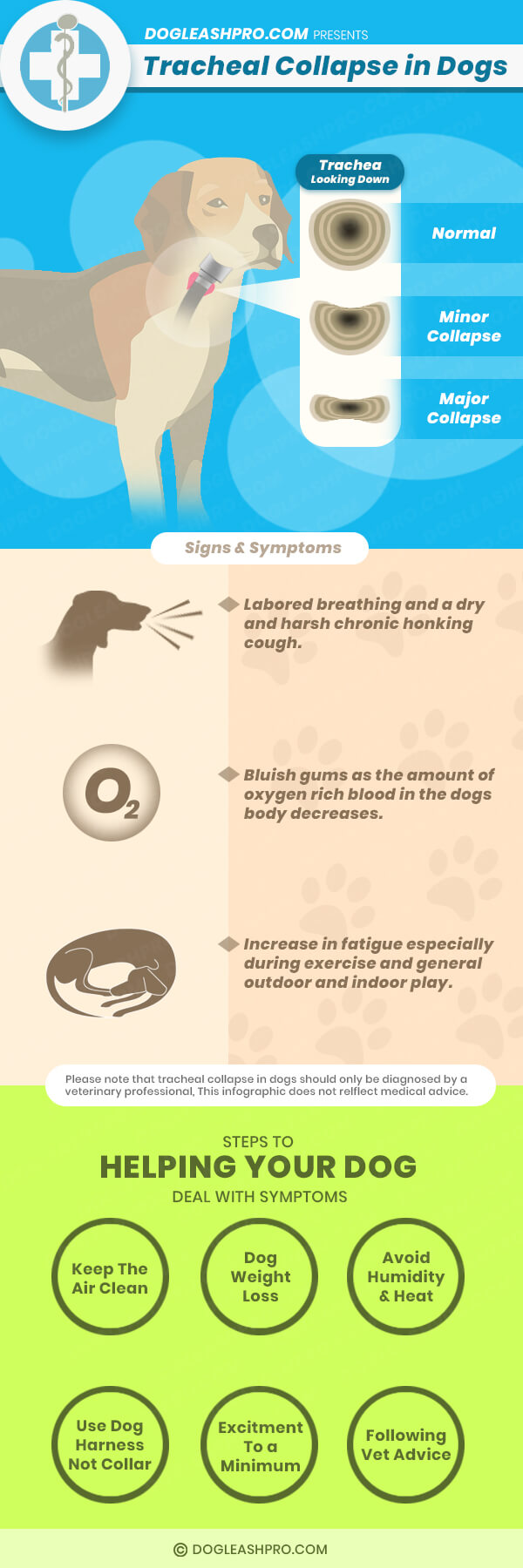
What is Tracheomalacia in dogs?
Tracheomalacia is the progressive collapse of Trachea with the flexible C-shaped cartilaginous rings around the structure weakening.
The Trachea is a pipe-like organ that forms part of the respiratory system in the neck and upper chest. It connects the larynx and the lungs and serves as the pathway of air for breathing.
Signs that a dog has Collapsed Trachea include a dry, honking cough sound, difficulty in breathing, and bluish tongue and gums.
The cause of Collapsing Trachea in Dogs can be due to several factors, but the main origin could be genetics since it affects mostly small-breed dogs.
What causes Collapsed Trachea in Dogs?
The causes of Collapsed Trachea in dogs could be genetics, environment, or due to concurrent disease. Listed below are possible causes of Tracheal Collapse in Dogs:
1. Genetics
While Trachea Collapse in dogs can be observed in all breeds, the smaller breeds like the Chihuahua, Pomeranian, Shih Tzu, Toy Poodles, and Yorkshire Terriers seemed to be more susceptible to the condition.
2. Obesity
Excessive fat tissue around the trachea can put pressure on the cartilage causing difficulty in breathing.
3. Upper Respiratory Tract Infection
A dog with Collapsed Trachea can also be due to a bacterial infection or kennel cough.
4. Heart Enlargement
Dogs with congestive heart failure or heart murmur can enlarge the heart which in turn puts pressure on the surrounding tracheal area.
5. Post-anesthesia effects
A dog that has undergone surgery wherein an endotracheal tube was inserted inside the throat could weaken the surrounding cartilage of the trachea.
6. Environmental irritants
Other Collapsed Trachea in dogs causes include environmental irritants like cigarette smoke and air fresheners or even perfumes.
7. Age
Tracheal Collapse is more common in older or middle-aged dogs than younger ones.
Puppy Collapsed Trachea
Tracheal Collapse puppy is due to a congenital disorder wherein there are not enough cartilaginous rings around the trachea.
A puppy can live a normal life with this condition but may eventually develop difficulty in breathing and swallowing in later years.
What are the stages of Tracheal Collapse in dogs?
A dog Collapsed Trachea condition can be classified into four (4) stages from mild to severe. Let’s go over these four stages below:
First Stage:
There are no discernible symptoms evident that would cause alarm. You may observe occasional coughing every now and then. The Tracheal cavity still retains its normal shape but some of the cells supporting the Tracheal structure may be weakening.
Second Stage:
The cartilaginous rings are partially flattened with the Tracheal cavity reduced by 50%. Clinical signs include rapid breathing and wheezing.
Third Stage:
During the third stage, the Tracheal cavity is obstructed by almost 75% with the cartilage almost flat. Your furry friend would have difficulty swallowing and may show signs of restlessness.
Fourth Stage:
The fourth and final stage of Tracheal Collapse in Dogs include severe distress in breathing. Your pup will be in pain and may faint. You may see some bluish gums and tongue.
During this stage, the Tracheal cavity is unfortunately completely Collapsed with the cartilage flat.
How serious is a Collapsed Trachea in Dogs?
Tracheal Collapse is a progressive disease that can be life-threatening if not managed properly with medication and preventative care.
Dogs with Collapsed Trachea are typically prescribed anti-inflammatory and cough suppressant drugs to minimize the symptoms.
Surgery is an option for a collapsing airway by placing a cylindrical prosthesis to open up the airways.
Is a Collapsed Trachea in Dogs fatal?
Yes, Tracheal Collapse in Dogs can be fatal in severe cases and if it’s not properly diagnosed early on by your veterinarian.
How is a Collapsed Trachea in Dogs fatal? Here’s why:
If your K9 friends can not breathe due to an insufficient amount of air from the narrowing of the Collapsed Trachea, then they may have respiratory distress and can potentially die.
The good news is that life-threatening and severe cases of a Collapsed Trachea in Dogs are rare. In most cases, Dogs with Tracheal Collapse will start to cough a lot. This should catch your attention and prompt you to contact your dog’s vet as soon as possible.
Early detection is key so that the condition does not worsen to respiratory distress.
If you’re not sure, it’s always best to consult with your vet. Your vet will perform a series of tests on your canine friends and provide you with the proper diagnosis so that treatments can be properly administered.
As dog owners, be aware of this health problem especially if you have small dog breeds like Yorkshire Terriers, Teacup Poodles, Miniature Poodles, and Chihuahuas or if you have older dogs.
Again, if the Tracheal Collapse in Dogs is not detected early and this health problem advances, it can be fatal.
If the Tracheal Collapse in dogs become severe, you can ask your vet for treatments like Tracheal stenting.
Tracheal stenting is when the vet places a rigid structure inside (or outside) your pup’s windpipe to permanently hold it open to prevent the Trachea from Collapsing again. This allows your pooch to breathe well again.
How to know if Dog has Collapsed Trachea?
One of the clearest signs of Trachea problems in dogs is a continual, severe dry cough with a honking sound. Collapsing Trachea dog will also experience quick fatigue due to air not fully reaching the lungs properly.
If the condition is not promptly managed, it may lead to severe consequences leading to a dog collapsed and breathing heavy. It will eventually affect their heart, lungs, liver, and kidney.
Signs and Symptoms of Dog Tracheal Collapse
The weakening of your dog’s tracheal cartilage restricts airflow to their lungs leading to labored breathing and a dry and harsh chronic honking cough.
As the dog’s trachea begins to fail and collapse oxygen has a harder time reaching the lungs. This lack of oxygen often leads to bluish gums as the amount of oxygen-rich blood in their body decreases.
Canine Tracheal Collapse is also characterized by an increase in fatigue especially during exercise and general outdoor and indoor play. You may notice your dog is not as active as they once were.
Please note that Tracheal Collapse in Dogs should only be diagnosed by a veterinary professional, and any recommendation for euthanizing your dog should be discussed with your dog’s vet.
What are the symptoms of Collapsed Trachea in Dogs?
Symptoms of Tracheal Collapse are the ones that are observed by dog owners like you. For instance, a dog coughing that sounds like honking is a symptom. Naturally, you’d take your dog to the veterinary clinic to find out what’s causing that particular symptom.
If you suspect your canine friends have Collapsed Trachea, here are some symptoms of dog Tracheal Collapse to look out for.
Some of the symptoms of Collapsing Trachea or Tracheal Collapse symptoms are:
Dry cough with a honking sound
One of the hallmarks of Tracheal Collapse dog symptoms is a dry, persistent cough with a goose-honking sound.
The sound is produced when air is trying to push through the narrowing passageway as they exhale.
These bouts of coughing may be triggered while eating and drinking, after an exercise, or during humid weather.
Difficulty breathing
As the airway progressively narrows, abnormal or noisy breathing sounds like wheezing may be noticeable.
Exercise intolerance
Another Tracheal Collapse in dogs symptoms is if your dog seems to have low energy or even unwillingness to participate in some physical activity.
You might notice at first that your dog would have coughing episodes right after a walk or even after some light physical exertion.
Retching
One of the common symptoms of Tracheal Collapse in dogs is dry heaving or retching. They might make an effort to throw up even when they haven’t eaten anything.
Fainting
One of the more serious symptoms of Collapsed Trachea is when your dog has fainting spells or has collapsed after a bout of coughing. With not enough air entering their bloodstream, oxygen levels in the brain drop causing them to blackout.
If you notice any of the above dog Tracheal Collapse symptoms, we highly recommend that you reach out to a vet as soon as possible.
Dog Tracheal Collapse cough
Tracheal cough or a Collapsing Trachea dog cough has a distinct sound different from a common cough or kennel cough. Tracheal Collapse cough or a dog coughing Collapsing Trachea is often dry without any phlegm present and trachea cough in dogs has a honking goose sound.
Dog Trachea cough or a Collapsed Trachea cough happens when a dog is exhaling. It is when the dog inhales that the trachea collapses.
Sometimes a dog with Collapsed Trachea won’t stop coughing or the coughing would be persistent for several minutes. This is because the rapid inhalation and exhalation of air prevent the trachea from widening.
Collapsing Trachea cough is different from a reverse sneeze wherein the coughing occurs during inhalation.
Tracheal cough in dogs or a dog coughing Tracheal Collapse is also different from kennel cough when a dog would usually gag at the end of a cough.
Let’s discuss the difference between the two next.
Kennel cough vs Collapsed Trachea
To know whether your dog is suffering from kennel cough or Tracheal Collapse is through the sound of their cough.
A kennel cough typically produces a hacking sound in the throat like there is something stuck inside. A Collapsed Trachea would produce a more goose-honking sound as if they are running out of breath.
Another indicator of whether it is a kennel cough or Collapsed Trachea is when phlegm is produced. Dogs with kennel cough often cough up a foamy mucus while those with Tracheal Collapse have a dry cough.
Cough medicine for Dogs with Collapsed Trachea
The best cough medicine for dogs with Collapsed Trachea that is usually prescribed by veterinarians is dog cough medicine Collapsed Trachea suppressant.
Cough tabs for dogs with Collapsed Trachea such as cough suppressants work by minimizing the impulse to cough thereby reducing inflammation and irritation in the Trachea.
Cough suppressant for dogs with Collapsed Trachea
The cough suppressants for dogs with Collapsing Trachea that can be prescribed are hydrocodone bitartrate, butorphanol, and tramadol. These drugs are classified as an opioid agonist that works on the receptors of the brain to reduce the cough reflex.
Cough suppressant dogs Collapsed Trachea recommended dosage is 0.1 to 0.25 mg per pound of the dog given every 6 to 12 hours. The administration of the drug is prescribed for up to a week depending on the severity of coughing.
Benadryl for Collapsed Trachea in Dogs
Benadryl for Tracheal Collapse is also effective as a cough suppressant. Benadryl, or diphenhydramine, is an antihistamine that is typically used to relieve allergies and sneezing as well as reduce swelling and inflammation
However, before you give your K9 friends over-the-counter medications like Benadryl, we recommend that you check with your vet first.
It’s important to note that Benadryl is not a specific treatment for conditions like a Collapsed Trachea in dogs. In fact, it could potentially have side effects like sedation, dry mouth, and urinary retention.
Instead of giving your pups Benadryl, try giving them Pet Wellbeing Throat Gold For Dogs instead. It is specifically designed to support throat health in dogs and alleviate discomfort related to conditions like a Collapsed Trachea.
Robitussin for Dogs Collapsed Trachea
Another cough suppressant that can be used is Robitussin or dextromethorphan. It is an over-the-counter drug that works well for dry cough by suppressing the cough reflex.
The proper dosage of Robitussin is 0.5 to 1 mg per pound of dog every 12 hours. The liquid form is more suitable for smaller dogs since it is easier to swallow.
Maltese Collapsed Trachea symptoms
Maltese Collapsed Trachea symptoms include a dry cough with no phlegm and a honking sound. Maltese Trachea Collapse will also elicit a cough every time the neck is slightly pressed.
Yorkie Collapsed Trachea symptoms
Collapsed Trachea symptoms in Yorkies are similar to other small breeds. Collapsing Trachea symptoms include easily coughing when picked up or when there is slight pressure applied to the neck.
Collapsed Trachea Pomeranian symptoms
Collapse Trachea symptoms in Pomeranian include difficulty in breathing and honking cough sounds.
Pug Collapsed Trachea symptoms
Damaged trachea symptoms in Pug are also labored breathing and coughing when the neck is lightly touched.
Shih Tzu Collapsed Trachea symptoms
Symptoms of Tracheal Collapse in Shih Tzu include difficulty in breathing, coughing, and restlessness.
Chihuahua Collapsed Trachea symptoms
Tracheal Collapse symptoms in Chihuahuas include difficulty in breathing, honking coughing sounds, and gagging when drinking and eating.
How to tell if your Dog’s Trachea is damaged?
A potential sign that there is Trachea damage in dogs is when your dog starts to cough easily when they start to pull on their leash while taking them out for a walk. This is also true when you lightly rub their neck area and they start to gag or cough means that there could be a damaged Trachea.
A severe Collapsed Trachea in dogs would show signs of cyanotic episodes, such as bluish gums and tongue.
Can you feel a Collapsed Trachea in a Dog?
It can be hard to feel a Collapsed Trachea in a Dog since the damaged portion could be anywhere in the trachea. The trachea extends from the cervical part of the neck deep into the thoracic area in the rib cage.
But, one way to test damaged Trachea in dogs is when they elicit a cough easily when you lightly press their throat.
What prevents the Trachea from Collapsing?
Collapsible Trachea in dogs can only be prevented through either intraluminal tracheal stents or surgical extraluminal prosthesis.
A veterinarian may advise implanting an expandable, mesh-like stent that would hold the Trachea in place. This intraluminal technique is a non-invasive procedure performed under anesthesia.
A Trachea can also be prevented from collapsing by surgically placing a prosthetic ring around the outside of the trachea.
Can a Collapsed Trachea heal itself?
Unfortunately, a dog Collapsing Trachea cannot heal by itself. It is a progressive, incurable condition that can be mitigated through medication and proper management.
Why is Collapsed Trachea worse at night?
Collapsed Trachea usually might worsen when the dog is asleep. Just like humans, dogs may experience excitement while dreaming during the REM sleep phase.
This raises the heart rate and therefore would cause the dog to breathe faster to take in more oxygen. Having a doggie bed with raised edges or a pillow will help them to breathe easier while sleeping.
What to do when your dog’s Trachea Collapses?
Depending on the severity of the disease, Tracheal Collapse can be managed through a combination of medication, lifestyle changes, and, in some cases, surgery.
Medication
There are no drugs that can directly cure Tracheal Collapse. It is through the use of cough medications, such as suppressants and bronchodilators in conjunction with anti-inflammatory drugs and antibiotics that will greatly reduce the severity of the disease.
Proper Home Care
Changing the diet of your dog to maintain a healthy weight goes a long way in managing Tracheal Collapse. Excess fat in the neck area can pinch the trachea which could further exacerbate coughing.
Keeping your home dust-free and free from cigarette smoke or fragrant aerosols can also help your dog to breathe more freely.
And, using a harness instead of a collar when taking your dog for a walk would decrease unnecessary pressure on their neck.
Surgery
For severe cases, surgery may be the last option.
For many dogs that have Tracheal Collapse, medication alone can help mitigate the effects of the disease, but for some, placing a device that could support the trachea may be needed.
The veterinarian may advise either a stent mesh tube or an extraluminal tracheal ring prosthesis.
Here’s how to diagnose Collapsed Trachea in dogs
Coughing in dogs may be a symptom of various diseases with Tracheal Collapse being one of them.
Since the symptoms of Collapsed Trachea dogs may come and go during the early phases, a thorough examination by the veterinarian is the only sure way to know if your dog is suffering from this condition.
X-Ray
The first test a vet might perform after suspicion of Tracheal Collapse through initial physical examination is a neck and chest X-ray. This is not a very accurate test since the collapse may be hard to detect in the early stages.
Fluoroscopy
Fluoroscopy is a more thorough examination since it uses real-time X-ray video imaging. A Collapsing Trachea is more visible when the dog is breathing with the exact location pinpointed.
Bronchoscopy
This procedure involves inserting a camera into the throat and examining the insides of the trachea. Bronchoscopy can detect the shape of the trachea whether it is rigid or collapsing in some portions.
Collapsed Trachea Dog Specialist near me
Here is a list of three (3) veterinary clinics that has an in-house Collapsed Trachea dog specialist:
- Animal Specialty and Emergency Hospital (superiorveterinarysurgery.com) is located in Florida. The hospital has an in-house surgeon whose special interests include Tracheal stenting.
- If you’re in California, you can consult with Dr. Chris Wong, DVM, DACVECC whose areas of interest are surgery and emergency medicine. You can find him at the VCA Animal Hospital (vcahospitals.com/sacramento-veterinary-referral-center/team/chris-wong), in Sacramento, CA.
- Dallas Veterinary Surgical Center (dvsc.com/medical_library/tracheal-collapse) has a team of surgeons that specializes in animal surgery.
What are the signs of Collapsed Trachea in Dogs?
If you notice any of the above symptoms of Collapsed Trachea, it’s time to call your vet.
If you observe your dog suddenly showing a symptom of retching, you’ll want to head to the nearest veterinary clinic to have your dog assessed by a professional.
At the clinic, your vet will perform a thorough physical examinations as well as chest X-ray and bronchoscopy to properly diagnose the issue and confirm the signs of Tracheal Collapse in dogs with you.
Other than a dry cough, not all dogs show the same symptoms and signs of Trachea Collapse in dogs. Some dogs with Tracheal Collapse will have signs of breathing difficulties while others won’t. Some of them will show signs of bluish gums and tongues while others don’t.
This is why the treatment options such as what medicines to prescribe will be based on the signs of a Collapsed Trachea in dogs.
Generally, one of the early signs of Trachea Collapse in dogs is a dry cough. A dry cough is characterized by having a honking sound, hence, it’s referred to as a goose-like-sounding cough. A dry cough also does not produce phlegm or nasal discharge.
As the disease advances, other signs of Dog Tracheal Collapse will begin to show. The treatment will then be based on the signs of Collapsing Trachea in dogs such as:
- A wheezing sound
- Non-productive cough with no phlegm
- No fever
- Bluish gums and tongue
- Coughing or wheezing when excited
- Coughing when picked-up
- Fainting
What is Collapsed Trachea in small dogs?
Not all dog breeds are susceptible to Collapsed Trachea. In most cases, Tracheal Collapse in small dogs is commonly seen.
But that doesn’t mean that the disease is exclusive only to small dog Collapsed Trachea. Medium or large breeds can also suffer from this disease.
Small dog Tracheal Collapse is suspected to be related to genes.
So, why is Collapsing Trachea in small dogs more common compared with big dogs? Human intervention has something to do with it.
Dogs are by nature, medium to large-sized, weighing from 40 to 50 pounds. But, us humans wanted to care for smaller dogs.
Hence, we practiced inbreeding to create smaller breeds of dogs. This human intervention produced small breeds with small trachea in dogs.
While small dogs are born with strong cartilage that is capable of supporting the trachea, age weakens the cartilage. This is the reason why a small dog suffers from Tracheal Collapse.
Yorkie Collapsed Trachea
Among small breeds of dogs, Yorkies are the most vulnerable to Tracheal Collapse. It is estimated that about 65% of Tracheal Collapse cases comes from Yorkies. Gender is not a factor in the distribution of Trachea Collapse Yorkie cases.
Up to this date, no one can exactly pinpoint why a Collapsed Trachea Yorkie is more common compared to other smaller breeds. But it is highly suspected that Collapsed Trachea in Yorkies is due to genetics.
The onset of symptoms for Tracheal Collapse Yorkie varies. Some of them begin showing signs as early as 1 year old while some at a later age and some even at 15 years old. And Tracheal Collapse is one of the leading causes of Yorkies’ breathing problems.
Do Yorkies have breathing problems?
Yes, aside from Tracheal Collapse, Yorkies can have breathing problems due to other forms of illness. The breathing problems in Yorkies may be due to chronic obstructive pulmonary disease or canine distemper virus.
How can I help my Yorkie with a Collapsed Trachea?
You can help your Yorkshire Terrier Trachea problems by employing the following:
- Using a harness instead of a neck collar.
- Avoid exposing your Yorkie to cigarette smoke, candles, perfumes, and air fresheners.
- Avoid exercising your Yorkie during the hottest time of the day or when it’s humid.
Chihuahua Collapsed Trachea
A Chihuahua Tracheal Collapse is also common in this breed.
The signs of a Collapsed Trachea Chihuahua are no different from other breeds. So, if you hear your Chihuahua coughing but is not producing phlegm, that could already be a manifestation of a Collapsing Trachea Chihuahua.
A Collapsed Trachea in Chihuahua also leads to respiratory distress such as difficulty in breathing and vomiting.
But it’s best to see a veterinarian to rule out Tracheal Collapse Chihuahua. It’s because another type of respiratory issue which is reverse sneezing is also seen among Chihuahuas.
Chihuahua reverse sneezing vs Collapsed Trachea
Reverse sneezing and Tracheal Collapse are respiratory issues that are commonly seen among small dogs.
Reverse sneezing is not a progressive disease and neither does it require treatment. It is caused by an irritant such as perfume that causes spasms in the throat. Pulling of the neck collar may also cause reverse sneezing which is characterized by a honking noise.
On the one hand, a Collapsed Trachea is a progressive disease that will produce serious signs including breathing difficulty and fainting.
Pomeranian Collapsed Trachea
Is a Pomeranian Tracheal Collapse also common? Yes, Pomeranians are small dog breeds that are prone to Collapsed Trachea.
The cause of a Collapsed Trachea in Pomeranians is thought to be genetics but can be exacerbated by weight and the improper use of a neck collar.
The other possible causes of Pomeranian coughing Collapsed Trachea are bronchitis, pneumonia, and tracheal tumors.
The signs of Tracheal Collapse in Pomeranian include:
- Honking Cough
- Wheezing
- Exercise intolerance
- Vomiting
- Bluish lips and gums
- Having a hard time breathing well
Collapsed Trachea in Pugs
Pug, being a brachycephalic breed is prone to respiratory issues like Collapsed Trachea. In most cases, the cause is genetics. But, for some, the cause can be due to a chronic disease that narrows the Pug’s airways.
Regardless of the cause, the signs are the same with other dog breeds and these are:
- Dry and honking cough
- Panting
- Retching
- Vomiting
- Inability to exercise
- Loss of consciousness
Shih Tzu Collapsed Trachea
A Shih Tzu is also prone to Collapsed Trachea. Here are the signs to watch out for:
- Coughing that does not produce phlegm
- Lack of energy due to breathing problems
- Trouble drinking and eating
- Blue-tinged gums
- Collapsing
Maltese Tracheal Collapse
It’s disheartening to see a small dog like a Maltese that weighs only an average of 4 to 8 pounds suffer from dry cough, panting, vomiting, and lethargy as a result of Tracheal Collapse.
How to help Dog with Collapsed Trachea?
If you find yourself thinking, “My dog has a Collapsed Trachea, but I don’t know the type of help for her!” don’t fret!
Here’s what you can do for Collapsed Trachea in dogs:
- Maintain its ideal weight.
- Prescription medicines for cough suppressants to reduce coughing episodes.
- Aside from anti-inflammatory medicines, you can also introduce Omega-3 fatty acids and antioxidants to reduce inflammation.
How to comfort a dog with Collapsed Trachea?
To comfort your dog with breathing difficulties, lethargy, and other symptoms of Collapsed Trachea, here are some ways to do it:
- Limit your dog’s exposure to hot air because it contributes to breathing problems.
- Keep your indoor air clean by using an air purifier with a HEPA filter.
- Use a harness instead of a neck collar to prevent pressure on the trachea.
How to carry a Dog with Tracheal Collapse?
When carrying your pooch, the most important thing to remember is to avoid straining his neck. The best way to carry your dog with Tracheal Collapse is by gently holding his chest with one hand and then using your other hand to support his buttock.
No worries if your pooch is diagnosed with Tracheal Collapse. You can still tag him with you at the mall, park, restaurants provided that you won’t allow him to walk long. This is why we recommend that you get a dog stroller for dogs.
WANT MORE INFORMATION? Check out Best Dog Stroller for Jogging (Reviews & Top Picks) to find the best dog jogging stroller for you and your pup!
What is the best sleeping position for Dog with Collapsed Trachea?
Sleeping on their side is the best position for dogs with Tracheal Collapse because it reduces the pressure on the trachea.
But don’t use an ordinary dog bed. Instead, invest in an elevated dog bed or a bed with a sloping contour with supportive bolsters where your pup can rest his head on.
This allows for easier breathing. Plus, you may also throw in a supportive blanket for added warmth.
DON’T MISS: Best Chew Proof Dog Beds (Reviews & Top Picks)
How to fix Collapsed Trachea in Dogs?
In case medications are unsuccessful in managing the signs and symptoms, a surgical correction may be considered. But this procedure is very invasive and costly.
It involves placing a stent in the parts of the trachea that collapsed. As with other types of surgical procedures, it comes with some risks. Plus, medications are still necessary post-surgery.
How to treat Tracheal Collapse in Dogs?
The goal of treating Collapsed Trachea in dogs is to improve their quality of life. Medications are given to lessen coughing and make breathing much easier as well as to avoid complications from cough.
Treating Tracheal Collapse in dogs involves the following:
Medicines
There is a variety of medicines prescribed to make breathing easier such as cough suppressants and bronchodilators.
Anti-vomiting medications can also be prescribed. To address inflammation for Collapse Trachea in dogs, corticosteroids are also prescribed as well as antihistamines and sedatives.
Avoidance of irritants
Avoid exposing your dog to irritants such as cigarette smoke, strong perfumes, and pesticides.
Surgery
This is only recommended for dogs who do not respond to medications. Tracheal stenting and tracheal prosthesis are the 2 forms of surgical procedures.
Dog Tracheal Collapse Home Treatment
This section is about the various dog Collapsed Trachea home treatment options.
Collapsed Trachea in Dogs Home Remedies
One of the home remedies for Collapsed Trachea in dogs is hydrocodone for Collapsed Trachea. This medicine is given to make the dog sleepy so he can rest well.
Hydrocodone is an opiate agonist that is used to treat pain and suppress cough. Sedation and diarrhea are 2 of the common side-effects.
Therefore, while hydrocodone is is one of the home remedies for Tracheal Collapse in dogs, the amount to give your furry friends is 0.1 mg to 0.25 mg per pound, 2 to 4x daily.
Because of the side-effects of the drug and its possible drug interactions, the duration depends on the response to the drug and the side-effects.
Temaril-P for Dogs with Collapsed Trachea
Temaril-P for dogs with Collapsed Trachea is a steroidal medication that reduces shortness of breath, coughing, and controls allergies.
Bronchodilators for Dogs with Collapsed Trachea
Other effective prescription medicines are bronchodilators like theophylline, albuterol, or terbutaline.
These drugs for bronchial collapse dog help to relax and widen the bronchi and bronchioles in the lungs putting less pressure on the trachea.
Bronchodilators are more effective in dogs suffering from a lower Tracheal Collapse.
Pomeranian Collapsed Trachea Home Treatment
You can do simple home treatment for your Pomeranian with Collapsed Trachea by keeping indoor air quality clean. You can use an air purifier with a HEPA filter to clean out all allergens inside your home.
How to treat Tracheal Collapse in Dogs naturally?
Aside from the prescribed medicines mentioned above, you can also integrate these with natural cure for collapsing trachea. The natural treatment for Collapsed Trachea in dogs is safe and less expensive.
Natural Remedies for Collapsed Trachea in Dogs
The natural remedies for Tracheal Collapse in dogs have no side effects. Some of the dog Collapsed Trachea natural treatment is a kitchen staple in most homes. One of the natural cures for collapsing trachea is honey.
Honey for Collapsed Trachea in Dogs
Giving your K9 friends honey, specifically Manuka honey mixed with some lukewarm water, can help dogs with Tracheal Collapse.
Manuka honey is effective in soothing the throat and suppressing the cough because it contains dihydroxyacetone (DHA), leptosperin, and methylglyoxal (MGO).
This means that Manuka honey has anti-fungal, anti-viral, and anti-inflammatory properties that help alleviate the signs of Tracheal Collapse.
Honey is not only natural, but it has been proven scientifically to be more effective than cough suppressing drugs like dextromethorphan.
You’ll want to mix 1 teaspoon (tsp) of Manuka honey with some lukewarm water in their doggy bowl. It’s best to give 1 tsp per 20 pound of weight. It’s best to give them 3x throughout the day, depending on the severity of your pup’s cough.
Holistic treatment for Collapsed Trachea in Dogs
A new approach to treating Collapsed Trachea in dogs is showing some promise in managing the symptoms. Some of these holistic treatments are acupuncture, Chinese herbs to reduce allergic reactions, chiropractic, Reiki or palm healing, and herbal supplements.
Treatment for Collapsed Trachea in Dogs
Early on, we discussed with you the treatment for Collapsing Trachea in dogs. In this part of the article, we’d share the other available treatment for Tracheal Collapse in dogs.
Most of the Tracheal Collapse dog treatment that we will itemize are chemical-free and do not produce negative side effects.
Here are the other Collapsing Trachea treatment for dogs.
- Antibiotics like cefazolin are prescribed for dog Collapsed Trachea treatment of infections.
- Cerenia to stop vomiting is prescribed for Collapsed Trachea in dogs treatment.
Aside from prescription medicines, there are Tracheal Collapse treatment dog that are all-natural and safe to use as Tracheal Collapse in dogs treatment.
- Using a dog harness for Collapsing Trachea treatment for dogs. A harness prevents putting pressure on the dog’s neck, thereby, is an effective treatment Collapsed Trachea dog.
- Stick to non-toxic and unscented household cleaning products for Tracheal Collapse treatment.
- Invest in a humidifier or vaporizer as a form of Collapsing Trachea treatment for increased moisture in your home.
- Supplementing glucosamine as Collapsing Trachea dog treatment to support the cartilage in the trachea.
- Fish oils have anti-inflammatory benefits to help in the Collapsed Trachea treatment dogs.
- Turmeric supplement chews also help reduce inflammation and can be used for the treatment for Collapsed Trachea.
- Collagen supplements help strengthen the cartilage in the trachea and can be given as a Collapsed Trachea treatment in dogs.
- Anti-oxidants like Omega fatty acids help reduce inflammation and are good as a Collapsed Trachea dog treatment.
- CBD oil helps soothe dry cough and is safe to use for Collapsed Trachea treatment.
- Another dog collapsing trachea treatment is marshmallow root. It eases coughing and is effective in dogs Collapsed Trachea treatment.
- Plantain as a treatment for Collapsed Trachea in dog. It relieves discomfort and reduces throat inflammation and is good for treatment for dogs with Collapsing Trachea.
- Colostrum beefs up the immune system and may be used for the treatment for dog Collapsed Trachea.
- Chinese herbs as a dog Tracheal Collapse treatment for the control of allergies.
- Antinol for dogs is worth trying as a treatment for Collapsing Trachea.
You have choices when it comes to Collapsed Trachea dogs treatment. We encourage you to talk to a professional about the dosage and safety precautions of the treatment for dogs with Collapsed Trachea.
Dog enlarged heart pressing Trachea treatment
ACE inhibitors, diuretics, and beta blockers are some of the maintenance medicines for enlarged hearts in dogs.
Dog throat injury from leash treatment
NSAID painkillers such as meloxicam are often prescribed for throat injury from leash injury. If your pup shows a reaction, physiotherapy or acupuncture can reduce inflammation.
To avoid any throat injury to your small canine friends, we recommend using a dog harness instead of a collar. Let’s discuss more about this next.
Choose a harness over a collar when going for walks
When a dog has tracheal collapse their windpipe’s cartilage is weakened so we want to avoid putting unnecessary stress on their necks.
It is a good idea to attach your dog leash to a comfortable dog harness instead of directly to your dog’s collar. This shifts the pulling tension from the neck and distributes it around the dog’s chest.
You can still use a dog collar for things like ID tags, but avoid using it for dog walking. It is also a good idea to make sure your dog’s collar is not too tight as this could cause further discomfort.
You can check out our breakdown of the collar vs harness where we discuss the key differences between the two and go over the advantages and recommendations for each.
Tracheal irritation in Dogs treatment
Cough suppressants like hydrocodone are prescribed to reduce inflammation in the Trachea.
Take into consideration current quality of life when making the decision to Euthanize your dog who is suffering from Tracheal Collapse. Here are some things to ask your vet.
- Determine if your dog is in pain and whether the pain can be managed with medication. This is something your vet can help you determine for sure.
- Is your dog still able to eat unassisted? Do you have to force-feed them?
- Does your dog have issues standing or is unable to stand on their own?
- Is your dog experiencing frequent diarrhea or vomiting accompanied by dehydration and weight loss?
- Is the dog suffering from breathing problems or chronic cough for prolonged periods of time?
- Your dog just seems out of it and has lost interest in commonly enjoyable activities they previously got excited about such as playing or walking?
If you notice a drastic change in your dog’s appearance, mannerisms, or energy it would be a good idea to seek the opinion of a qualified veterinary professional.
Before Euthanizing consider treatment options
New treatment options are always being developed as veterinary medicine advances. Be sure to speak to your vet about possible treatment options before making the decision to euthanize.
According to VCA Hospitals there are various treatment options ranging from prescription drugs to complex and specialized surgical treatments. However, it should be noted that regardless of the treatment your dog will still experience discomfort and cough throughout their lives.
In the end, you and your veterinarian will need to decide whether the cost of treatment and the potential gain to your dog’s quality of life is worth it before making a decision about euthanizing your dog.
Steps to help your dogs tracheal collapse
Although we cannot stop the condition from progressing we can alleviate some of the most common symptoms of canine tracheal collapse by making some changes to our dog’s environment and our actions.

Total Time Needed :
60
Minutes
Total Cost:
65
USD – 1000+ USD
Required Tools:
Things Needed?
Everyday Steps to help manage your dog’s symptoms:
Reducing pollutants in the air
Since tracheal collapse is made worse when your dog coughs it is a good idea to reduce any potential triggers in the air. An air filter can go a long way to helping to make sure your dog is breathing clean air.
In the long term, it can have a significant impact on the progression of your dog’s condition. Since the wearing down of the trachea occurs faster when your dog coughs reducing the likelihood of tracheal irritation can really help.
We recommend a good air filter to help you reduce irritants in the air. We currently use the one recommended below in our home and find it to be a very good choice which can easily handle even large rooms.
Dog Tracheal Collapse weight loss treatment
According to the American Medical Center weight control is a critical step to helping your dog manage their chronic cough caused by tracheal collapse. Being overweight contributes to breathing difficulties and induces coughing fits.
Developing a safe and effective diet and exercise plan for your dog can make a huge difference in their quality of life and significantly impact the severity of their symptoms.
Even a small amount of weight loss can have a dramatic impact on your dog’s quality of life when dealing with tracheal collapse symptoms. There are certain foods specifically designed to help your dog lose weight, talk to your vet to determine if low-calorie dog foods are a good fit for your canine companion.
Is a Collapsed Trachea in Dogs painful?
If you’re wondering, “Does a Collapsed Trachea hurt a dog?” the answer is yes, Collapsed Trachea in Dogs can hurt and can be painful.
This is because Collapsed Trachea makes breathing difficult. Therefore, some dogs will show signs like bluish gums and fainting due to a lack of oxygen supply. They will also have a difficult time swallowing their food.
Can a Dog recover from a Collapsed Trachea?
Unfortunately, dogs cannot recover from Tracheal Collapse. The medicines given to your precious pups will only reduce the symptoms but the Tracheal cartilage will continue to weaken.
If your furry friend’s coughing worsens, do not delay your trip to the vet.
How long can a dog live with Tracheal Collapse?
A dog who has a collapsing trachea typically lives up to 2 years from the time of official diagnosis. With surgical procedures, a dog’s life with this condition can be doubled to 4 years and up.
You can further extend a dog’s life by taking additional steps to help them manage their symptoms. Diet changes leading to weight loss and ensuring clean air can go a long way to improving your dog’s chances of living longer with this condition.
Avoiding unneeded strain such as using collars for walks, physical activity during humid hot days, and being careful not to overfeed your dog will also have a positive impact on their longevity.
Things to note about Canine Tracheal Collapse
The common symptoms of Tracheal Collapse in Dogs could also be a sign of other serious conditions such as heart failure. It would be a good idea to talk to your vet about getting your dog screened for other possible ailments.
Other issues such as liver disease are also common with dogs who suffer from tracheal collapse. Testing your dog’s liver function when bringing them in for evaluation could help your vet develop specialized treatments to tackle both of these conditions.
When should I Euthanize my dog with a Tracheal Collapse?
Dog Euthanasia is a very sensitive issue and in most cases, fur parents find it hard to decide if their dogs have to be put to sleep or not.
The Tracheal Collapse comes with complications and these should help you make that final decision if it’s about to let go.
Here are the signs that should tell you when to seriously consider Euthanasia for dogs diagnosed with Tracheal Collapse:
- Decreased appetite and anorexia
- Medicines are no longer providing relief for the symptoms
- The onset of either kidney or liver disease
- Disinterest in the usual day-to-day activities
- Frequent bouts of respiratory problems
- Suffers from secondary pneumonia
After making the decision to Euthanize
Saying goodbye to your pet is one of the hardest decisions you will have to make as a dog owner. Your dog is a part of your family and saying goodbye will be tough; especially on your kids if you have any. Be prepared to have a discussion with your family about your dog’s condition.
The American Humane Society recommends the following books to help your kids deal with the grieving process of losing a pet:
When a Pet Dies by Fred Rogers
Remembering My Pet by Machama Liss-Levinson and Molly Phinney Baskette
After you have made the decision to euthanize, be sure to give every member of the family time to say goodbye to your dog in their own way. Try to schedule a time and place for every member of your family to say their goodbyes before the procedure.
Be sure to ask your veterinarian about your options for the actual procedure. Some vets will come to your house and perform the euthanization. This option allows your dog to have their final moments in a place of comfort together with your family.
Consider not having children present during the actual euthanization. Depending on their age, this could be traumatic to them. This is a personal call and it is up to you whether you are comfortable having them present.
What to expect during the Euthanization
Your veterinarian will handle the entire procedure and help you answer any questions you may have. Depending on the size of your dog they will either be laid down on a table for the procedure if they are a large breed or held by a vet’s assistant if they are a small breed.
Your vet will then administer an injection with a syringe of sodium pentobarbital which is an anesthetic drug that will quickly cause your dog to lose consciousness and painlessly stop their heart. Your vet will confirm the time of passing by checking for a heartbeat and allow you a few moments with the pet.
This is the last time you will see your pet so mentally prepare yourself to say goodbye. Think back to any fond memories you had with your furry companion and know that they are now free from pain.
Know that you made the humane decision to not see your canine family member suffer and have given them a painless and quick end to their suffering.
What’s next after Euthanization?
You will need to make arrangements to have your pet either buried or cremated. This is a personal choice and your vet will typically give you the option to do either.
Cremation is often a popular choice as it allows you to keep your dog’s ashes in your home close to you and your family. There are many options available to help you commemorate your dog’s legacy.
If you opt to bury your pet you can look for a local pet cemetery or bury your pet in your yard. Please be advised that some towns have strict rules about pet burial so be sure to call your local town hall to inquire further.
Conclusion
Knowing when to euthanize a dog can be a tough personal choice. At the end of the day, it comes down to a humanitarian choice to end the suffering of your beloved pet. Seeking out the advice of both your family and your veterinarian to help you come to a decision about euthanizing is often the first step.
Know your options, pet medicine is evolving every day and new treatments are being developed by some of the brightest and most committed veterinary professionals worldwide. Euthanization may not be your only choice, make sure you have all the facts before making a decision.
DISCLAIMER: THIS WEBSITE DOES NOT PROVIDE MEDICAL ADVICE
The information, including but not limited to, text, graphics, images and other material contained on this website are for informational purposes only. No material on this site is intended to be a substitute for professional veterinary advice, diagnosis, or treatment. Always seek the advice of your veterinarian or other qualified health care provider with any questions you may have regarding a medical condition.

With over five years of specialized experience as an animal writer, my expertise lies in dog nutrition, health, behavior, grooming, and training. I am dedicated to delivering helpful and informative content that caters to the well-being of our furry friends. My primary goal is to empower pet owners with knowledge and ensure our canine companions thrive in health and happiness. In my free time, I love volunteering at local dog rescue centers.



